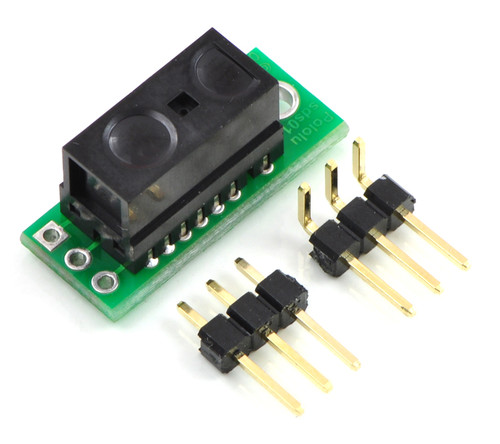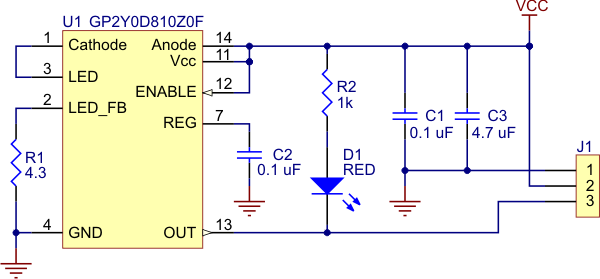
Pololu Carrier with Sharp GP2Y0D815Z0F Digital Distance Sensor 15cm
| SKU: | 109-1 |
This small digital distance sensor detects objects between 0.5 cm and 15 cm (0.2″ and 6″) away. With its quick response time, small size, low current draw, and short minimum sensing distance, this sensor is a good choice for non-contact, close-proximity object detection, and our compact carrier PCB makes it easy to integrate into your project.
There are a few millimeters of hysteresis around the maximum range threshold and no hysteresis at the minimum range threshold. Note that these sensors will only tell you if there is an object within the detection range along their narrow lines of sight; they will not tell you how far away the object is.
With detection distances up to 150 mm and a typical sampling rate of almost 400 Hz, these sensors provides an attractive alternative to shorter-range LED-phototransistor reflectance pairs and longer-range but slower sensors such as the Sharp GP2Y0A41SK0F analog distance sensor. The output, Vo, is driven low when the sensor detects an object; otherwise, the output is high.
Some example applications include:
- break-beam sensor or photogate alternative
- non-contact bumper or obstacle detector
- a counter or timer of objects as they pass by
Using the sensor
The Pololu carrier board lets you interface with the GP2Y0D805, GP2Y0D810, or GP2Y0D815 sensor using a three-pin 0.1″ connector, such as the included 3×1 straight male header strip and 3×1 right-angle male header strip. You can connect to these pins with a servo cable or with a custom-made cable using pre-crimped wires and a 3×1 crimp connector housing.
The square pad is ground, the middle pad is VIN (2.7 – 6.2 V), and the remaining pad is the sensor output, OUT. Depending on your power source, you might notice an increase in performance by placing a large (>10 uF) capacitor between power and ground somewhere near the sensor.
A red LED on the back of the PCB lights when the output is low, indicating that the sensor is detecting something. With the LED in the circuit, the low output signal will be around 1 V. If so desired, you can disable this LED by cutting the trace between it and the OUT pin where it is marked on the silkscreen or by desoldering the LED, in which case the low voltage will be below 0.6 V.
The GP2Y0D805, GP2Y0D810, and GP2Y0D815 have an optional enable input that can be used to put the sensor into low-power mode. The Pololu carrier board connects this input to Vcc so that the sensor is always enabled, but you can solder a wire to the pad labeled “enable” on the back of the PCB if you want control over this input. Note that you will need to cut the trace that connects the enable line to Vcc on the PCB if you want to be able to disable the sensor. This trace is marked on the silkscreen, and there is a caret that indicates where we suggest you make the cut.
The carrier board has a 0.086″ mounting hole for a #2 or M2 screw. You can make the module more compact by cutting or grinding off this portion of the PCB if you do not need the mounting hole.
Feature summary
- Operating voltage: 2.7 V to 6.2 V
- Average current consumption: 5 mA (typical)
- Distance measuring range
- GP2Y0D805Z0F: 0.5 cm to 5 cm (0.2″ to 2″)
- GP2Y0D810Z0F: 2 cm to 10 cm (0.8″ to 4″)
- GP2Y0D815Z0F: 0.5 cm to 5 cm (0.2″ to 6″)
- Output type: digital signal (low when detecting an object, high otherwise)
- Steady state update period: 2.56 ms typical (3.77 ms max)
- Enable pad can optionally be used to disable the emitter and save power (this feature requires you to cut a trace first)
- Size without header pins: 21.6 mm × 8.9 mm × 10.4 mm (0.85″ × 0.35″ × 0.41″)
- Weight without header pins: 1.5 g (0.05 oz)
 |
| Pololu carrier for Sharp GP2Y0D805Z0F, GP2Y0D810Z0F, and GP2Y0D815Z0F sensors schematic diagram. |
|---|





